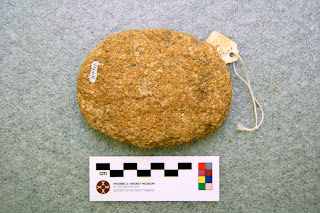Gamst collection included two other objects from Koken; all them dated back to the Neolithic. The catalogue card includes a bibliographic reference for a 1954 paper written by A.J. Arkell, a British Army lieutenant stationed in Khartoum, Sudan.
I previously mentioned that a complete inventory of the African archaeological collections was one of the first projects I started in my tenure at the museum. The accession file didn't include a copy of the paper and to my disappointment it was not available in any of the University of California libraries or the United States.
A few internet searches later I was surprised to find out that my friend and colleague Cinzia Perlingieri was involved with the archaeological site of Koken - as ceramic expert - in the late 1990's. She provided a copy of the paper for the museum file, told me stories about the site and the people who worked there and what doing archaeological research in difficult places like the Horn of Africa entailed.
Arkell's paper is historically significant albeit a little too technical and dry. Cinzia and her colleagues wrote shorter summaries of their research at Koken.You can read them here and here.

Hearst Museum 5-4711
palette
Africa, Eritrea, Agordat, Koken
Collected by Frederick C. Gamst, March 1965




















